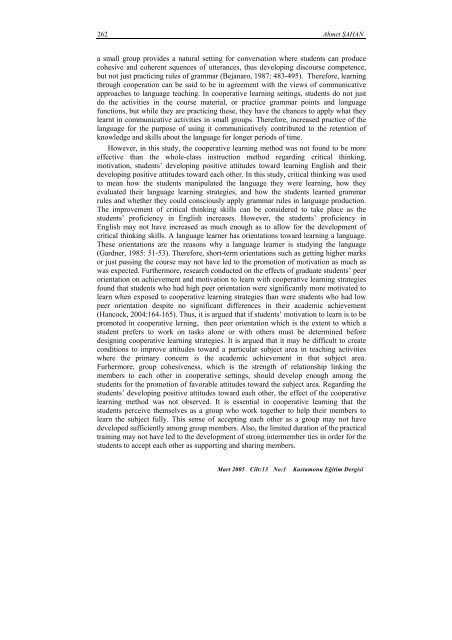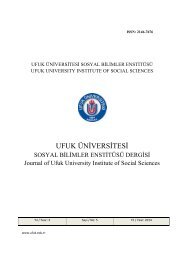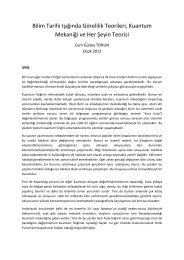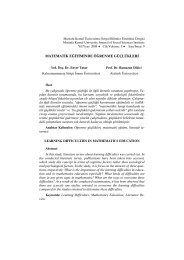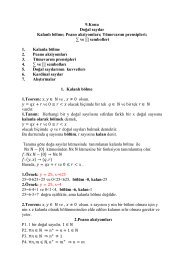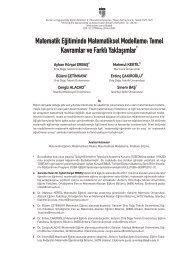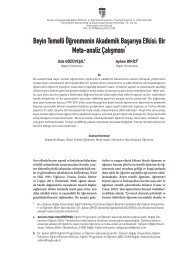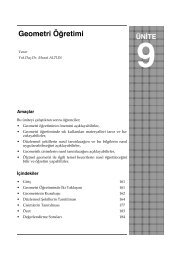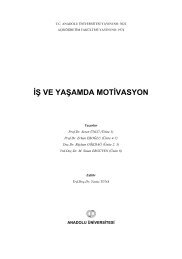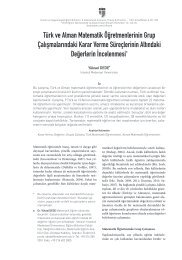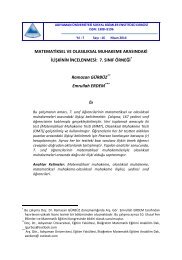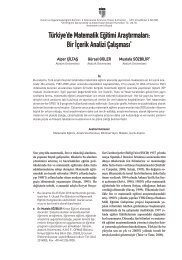You also want an ePaper? Increase the reach of your titles
YUMPU automatically turns print PDFs into web optimized ePapers that Google loves.
262 Ahmet ŞAHAN<br />
a small group provides a natural setting for conversation where students can produce<br />
cohesive and coherent squences of utterances, thus developing discourse competence,<br />
but not just practicing rules of grammar (Bejanaro, 1987: 483-495). Therefore, learning<br />
through cooperation can be said to be in agreement with the views of communicative<br />
approaches to language teaching. In cooperative learning settings, students do not just<br />
do the activities in the course material, or practice grammar points and language<br />
functions, but while they are practicing these, they have the chances to apply what they<br />
learnt in communicative activities in small groups. Therefore, increased practice of the<br />
language for the purpose of using it communicatively contributed to the retention of<br />
knowledge and skills about the language for longer periods of time.<br />
However, in this study, the cooperative learning method was not found to be more<br />
effective than the whole-class instruction method regarding critical thinking,<br />
motivation, students’ developing positive attitudes toward learning English and their<br />
developing positive attitudes toward each other. In this study, critical thinking was used<br />
to mean how the students manipulated the language they were learning, how they<br />
evaluated their language learning strategies, and how the students learned grammar<br />
rules and whether they could consciously apply grammar rules in language production.<br />
The improvement of critical thinking skills can be considered to take place as the<br />
students’ proficiency in English increases. However, the students’ proficiency in<br />
English may not have increased as much enough as to allow for the development of<br />
critical thinking skills. A language learner has orientations toward learning a language.<br />
These orientations are the reasons why a language learner is studying the language<br />
(Gardner, 1985: 51-53). Therefore, short-term orientations such as getting higher marks<br />
or just passing the course may not have led to the promotion of motivation as much as<br />
was expected. Furthermore, research conducted on the effects of graduate students’ peer<br />
orientation on achievement and motivation to learn with cooperative learning strategies<br />
found that students who had high peer orientation were significantly more motivated to<br />
learn when exposed to cooperative learning strategies than were students who had low<br />
peer orientation despite no significant differences in their academic achievement<br />
(Hancock, 2004:164-165). Thus, it is argued that if students’ motivation to learn is to be<br />
promoted in cooperative lerning, then peer orientation which is the extent to which a<br />
student prefers to work on tasks alone or with others must be determined before<br />
designing cooperative learning strategies. It is argued that it may be difficult to create<br />
conditions to improve attitudes toward a particular subject area in teaching activities<br />
where the primary concern is the academic achievement in that subject area.<br />
Furhermore, group cohesiveness, which is the strength of relationship linking the<br />
members to each other in cooperative settings, should develop enough among the<br />
students for the promotion of favorable attitudes toward the subject area. Regarding the<br />
students’ developing positive attitudes toward each other, the effect of the cooperative<br />
learning method was not observed. It is essential in cooperative learning that the<br />
students perceive themselves as a group who work together to help their members to<br />
learn the subject fully. This sense of accepting each other as a group may not have<br />
developed sufficiently among group members. Also, the limited duration of the practical<br />
training may not have led to the development of strong intermember ties in order for the<br />
students to accept each other as supporting and sharing members.<br />
Mart 2005 Cilt:<strong>13</strong> No:1<br />
Kastamonu Eğitim Dergisi


